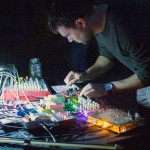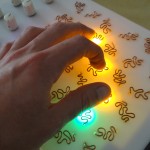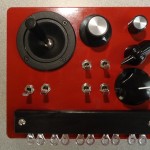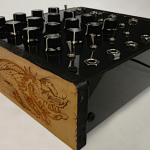Beyond new creative music work, CEMC also supports research. Center research has already won awards and garnered interest from beyond Cornell. Beginning in 2007, research on ambisonic sound spatialization and localization won the 2007 BOOM Sponsor Award (Credit Suisse) and in 2008 student Nathan Ward’s CUMotive (Wearable Interfaces for Cyberphysical Musical Expression) won the “Where’s the BOOM” award as well as an invitation to give a paper at the prestigious 2008 NIME (New Interfaces for Musical Expression) conference. Ward is a long- time contributor to CEMC and performed along with other CEMC composers and technologists at the first musical performance of any kind at Google (Administrative headquarters in New York, 2006 and again in 2007). The Google event set off a Cornell/Google collaborative effort to build an audio search mechanism, Search by Humming, developed at CEMC with Professor Graeme Bailey in Computer Information Science.
Some other examples of more recent research initiatives along with their specific artistic and musical outcomes include:
- Tyler Ehrlich’s ScoreViewer for Google Glass
Tyler Ehrlich’s ScoreViewer for Google Glass , a project initially conceived for use by Professor Cynthia Johnston Turner and the Cornell Wind Ensemble, provided a framework for the performance of Professor Kevin Ernste‘s AdWords™/Edward, the first commission piece of its kind for the Google Glass Explorers program.
Score “cards” can be uploaded directly from the web and called up verbally for performance (“OK Glass, perform Kevin’s piece”. Once loaded, performers “wink” through parts of the score (pages, cards, etc).
In AdWords™/Edward, winking advances through a series of short, repeated/looped phrases (see examples below, click to open) displayed in their glasses…a stylistic homage to Terry Riley’s In C, celebrating its 50th Anniversary year in 2014.
- Piano score example
- Conductor score example
- Clarinet score example
IMAGE: John Roark (www.johnroarkmedia.com)
Continue reading →
- Taylan Cihan’s custom electronic instruments
UPDATE: With profound sadness, I relay that Taylan Cihan, whose research and development at CEMC is featured below, has passed away–October 8th 2014. His instruments remain at the Center and are planned to be used as part of SoundLab, a DIY electronics initiative at Cornell that Taylan himself was, at the time of his death, working to implement.
***************************************************************************
Composition graduate student Tayan Cihan (DMA anticipated 2015) has developed a series of instruments at CEMC, primarily for his own use in live performances with the Cornell Avant Garde Ensemble (CAGE) and elsewhere. Each contributes to a continuously developing modular performance system, operating individually or generating layers within a collective. Below is a gallery of several of these instruments, created 0ver the last several years at CEMC.
Each instruments represents hundreds of hours of design and implementation, ranging from purely electronic circuitry through Arduino-based (open hardware) digital/analog hybrid devices, and onto integrated analog-digital mechanisms where computer and analog hardware are sharing, listening, and modifying on another. His endeavor with these devices is technical, practical, sonic, and aesthetic.
Further devices, complete instrument details, schematics, design rationale, sounds, video, and software code (where applicable) can be found on Taylan’s personal website.
Continue reading →
- DIY Synthesizer Workshop
Graduate student Taylan Cihan, along with Professors Kevin Ernste and Trevor Pinch and in conjunction with the Tompkins County History Center’s celebration of Ithaca’s rich history with the Moog Synthesizer (Switched-On: The Birth of the Moog Synthesizer) presented a series of hands-on synthesizer building workshops.
The most recent workshop, given on on Saturday, April 12th, 2014, from 2:00 – 5:00 p.m, was open to all ages and skills. Participants left with a working synthesizer. The events were sponsored by Ithaca Underground and with support of Cornell Electroacoustic Music Center and Department of Science and Technology Studies.

Polyphonic 4093 NAND Synth (build project from 4/12 workshop)

Step-by-step instructions for breadboarding a polyphonic 4093 NAND synth with built-in amplifier and several modifications. This is a simple and fun project for those who would want to get their hands dirty with analog electronics for the first time or have very little experience. Having said that, it is possible to get highly interesting sonic results with the suggested modifications that appear mid-way through. This is a set of instructions that I have used in a public workshop that took place at the Tompkins History Centeron April 12 as a part of their ongoing exhibition, Switched-On: The Birth of the Moog Synthesizer
Continue reading → - Ray Li’s Aura, SoundSpace, and related work
Ray Li, BS ’14 (Music 1421, 2421, Independent Study) and Michael Ndubuisi, BS ’14 (Music 1421), designed Aura (later evolving into SoundSpace), a new instrument that allows the musician to shape and control sound through hand movements.
SoundSpace uses electromagnetic sensors to track the exact position of the gloves in space. The motion of the musician’s hands can trigger prepared sounds, play different notes and add musical effects.
“We wanted to imagine sound as a tangible thing that you can hold between your hands,” Li said. “We’ve tried to create something that can basically do anything that you could do in a normal sound-editing computer program.”
Aura on Cornell Daily Sun video on Aura.
Video courtesy of the Cornell Daily Sun. Videographer: Ryan Larkin, film major.
Discovery Channel Daily Planet feature:
The software for Aura has, more recently, been expanded into SoundSpace including recent performances with the Cornell Symphony Orchestra and as a solo instrument as with the demonstration of SoundSpace is below.
Continue reading → - SudoGlove and SudoSynth
Jeremy Blum’s SudoGlove (also SudoSynth) is “a gesture controller that can be easily interfaced with hardware or software via a wireless connection. The glove implements an array of sensors plus filtering circuitry and mathematical analysis firmware to derive state values for each sensor and transmits them to an authorized receiver. I have used the glove to drive an RC car, to synthesize music, to manipulate openGL video, to control arbitrary processing software, and to control performance lighting effects.”
The instrument and its varied applications was featured in April 2011 on the Discovery Channel’s Daily Planet.
A complete summary, details of further uses, pointers to additional research and publicity, and links to code (Creative Commons License) can be found on Jeremy’s own (very thorough) page here.
A music-specific discussion of the development and application of SudoGlove/SudoSynth to performance is here.
SudoSynth demonstration:
Continue reading → - CUMotive: wireless wearable accelerometers for music
In the Fall of 2007, undergraduate Nathan Ward presented several demonstrations of his CUMotive system, the culmination of his work in music and engineering (CEMC, Electrical Engineering), part of his independent major. CUMotive was the recipient of the 2008 “Where’s the BOOM” Award at Cornell’s Bits on Our Mind (BOOM) technology exhibition.
CUMotive code and information is available online. See here for a more complete description of the work as presented for ECE 4760, Designing with Microcontrollers. This work was also presented at the NIME (New Interfaces for Musical Expression) Conference 2008 in a paper entitled Wearable Interfaces for Cyberphysical MusicalExpression. CEMC and Professor Kevin Ernste appear in the acknowledgements.
Nathan began at CEMC as a student of Music 1421 and proceeded to take a series of courses through Music 6420/4420 followed by an Independent Study focussed on the work below. In addition to this series of demonstrations (in Lincoln Hall B20), Ward presented this work in 2009 as a composition for live contortionist and electronics (excerpt below).
An example of a wireless accelerometer system with gesture recognition capabilities:
A few examples using a custom wearable accelerometer system as a gaming controller:
Continue reading →















